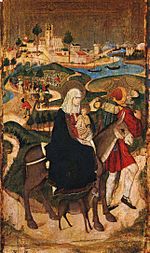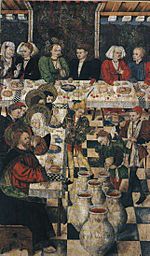Martín de Soria facts for kids
Martín de Soria was a Spanish painter who lived and worked between 1449 and 1487. He painted in the Gothic style, which was popular at the time. His art also showed influences from Flemish painters. Martín de Soria was active in the Kingdom of Aragón, a powerful kingdom in what is now Spain.
His painting style was similar to another famous painter, Jaume Huguet. Sometimes, people even confused their early works!
Contents
Early Life and Training
Martín de Soria likely started learning to paint in his uncle's workshop. His uncle was Blasco de Grañén, who was also a painter. Blasco de Grañén helped Martín de Soria with his work, acting like his agent.
In 1457, Martín de Soria and another artist named Juan Rius received an important job. They were asked to create an altarpiece for the town of Aguilón. An altarpiece is a large work of art, often painted or carved, placed behind the altar in a church. His uncle, Blasco de Grañén, promised that the work would be done well.
Completing Important Projects
After his uncle passed away in 1459, Martín de Soria took over some unfinished projects. He completed altarpieces in Épila and Ejea de los Caballeros.
The altarpiece in Ejea de los Caballeros was for the Church of San Salvador. This large project was not fully finished until 1476. In 1986, the altarpiece was cleaned. During this cleaning, experts found clues that suggested Martín de Soria might have painted the entire piece himself.
Other Notable Works
Also in 1459, Martín de Soria made a deal with a merchant named Miguel de Baltueña. He was hired to create an altarpiece for Baltueña's private chapel. This chapel was located in the Church of San Pablo in Zaragoza.
Some parts of this altarpiece were damaged over time. They had been poorly repaired in the past. Today, these panels can be seen at the Zaragoza Museum.
Between 1469 and 1471, Martín de Soria painted a work called "Virgen del Campo" (Virgin of the Countryside). This painting is located in Asín. For a while, people thought this painting was done by Jaume Huguet, but now we know it was Martín de Soria's work.
Later Career
It wasn't until 1485 that another work was definitely known to be by Martín de Soria. This was the main altarpiece for the church in Pallaruelo, a town in Huesca. This altarpiece was special because it had Martín de Soria's signature and the date it was finished.
Sadly, most of the panels from this altarpiece were destroyed in 1936. This happened during the Spanish Civil War, a difficult time in Spain's history. The panels that survived can be seen at the Diocesan Museum in Huesca. We only know about the other panels from old photographs.
See also
 In Spanish: Martín de Soria para niños
In Spanish: Martín de Soria para niños




